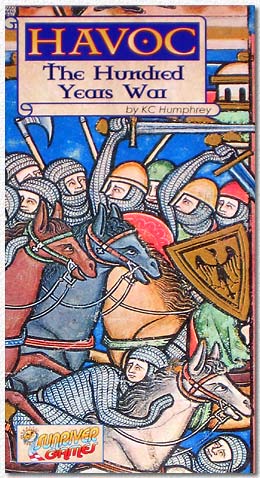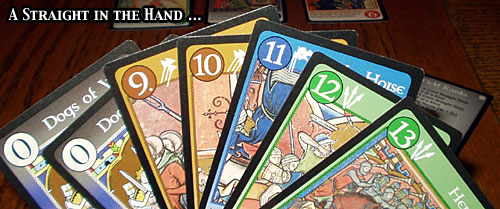Now, back to gaming:
I have developed a better way of explaining Havoc on Parade (my adopted title for my own experimental modification of the poker-style game Havoc with the linear game Parade) which I would like to share. It has worked quite well in play-testing.
I am currently signed up to GM (teach and lead games) at MACE, a gaming convention. I plan to show off my modifications there.


To wit:
This is a thoughtful combination of the game Havoc and the game
Parade. Well, Havoc cards with Parade rules meshed with Rich game
logic (oh, dear). Anyone mildly familiar with either might be curious
to see this unique (as far as I know) modification. All welcome. Each
player represents a general for the advancing French army during the
Hundred Years War. Each player sends troops (card plays) to face the
English, and any troops (cards) beaten under your leadership are
counted as negative points.
Each player represents a general for the advancing French army during
the Hundred Years War. Each general (player) sends troops (card plays)
to face the English, and any troops (cards) beaten under your
leadership are counted as negative honor (points). Cards are
eliminated (score negative Honor points) if they are weaker (not a
higher number than card played) AND if any cards are in the same
regiment (same color). Usually "strong" troops "protect" weaker ones,
although troops of the same color all are eliminated regardless. Each
soldier (card) eliminated under your leadership (on your turn) is
counted as negative honor (points) equal to their rank (printed
number), unless their regiment (color) becomes heroes. Whichever
general (player) has the most of any regiment (color) eliminted under
his leadership (in his/her points area) converts those troops to
"Heroes," which are not as dishonorable (not as negative). Heroes are
counted negatively as follows: -1 for 4 or more players, -2 for 3
players, and -3 for 2 players. New troops (the one card played during
your turn) are fresh to battle (immune from elimination themselves)
and simply affect the course of the battle for existing troops
(provide the benchmark for what is elimated that turn). Once new
troops are unavailable (draw deck exhausted), there is one more sally
(one more round, which each player playing his/her last card to reach
a hand of 4). Now, we tally honor (points), with each player adding 2 out of 4 cards in hand to negative score pile, while the remaining two are removed from the game. This allows a final element of unpredicatability.
Each player is dealt 5 cards to begin the game. Their hand limit can
never be modified and should never change (except in the last round).
If it does (thru player forgettfulness) they may, at any time, simply
explain themselves and draw up to 5. The complete deck of all cards is
casually divided into a part to enter play and a half to set aside.
The size depends on the patience of the players, and game length
desired. At least half of the deck should be used, but never the full
deck (missing numbers/colors add to the unpredictability of the game).
Choose a player to go first. Their card is fresh to battle (immune
from elimination the turn played), battle losses are counted (none in
early play), current player draws a card to refresh to 5, and play
moves to the next player.

Thanks for writing this.
ReplyDelete